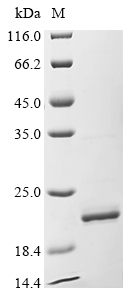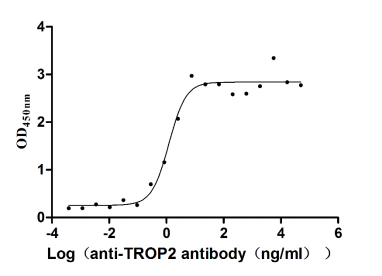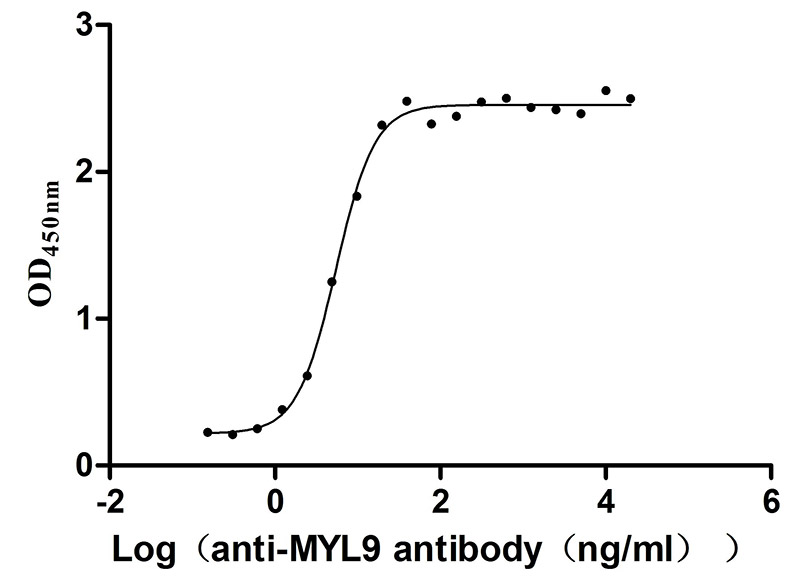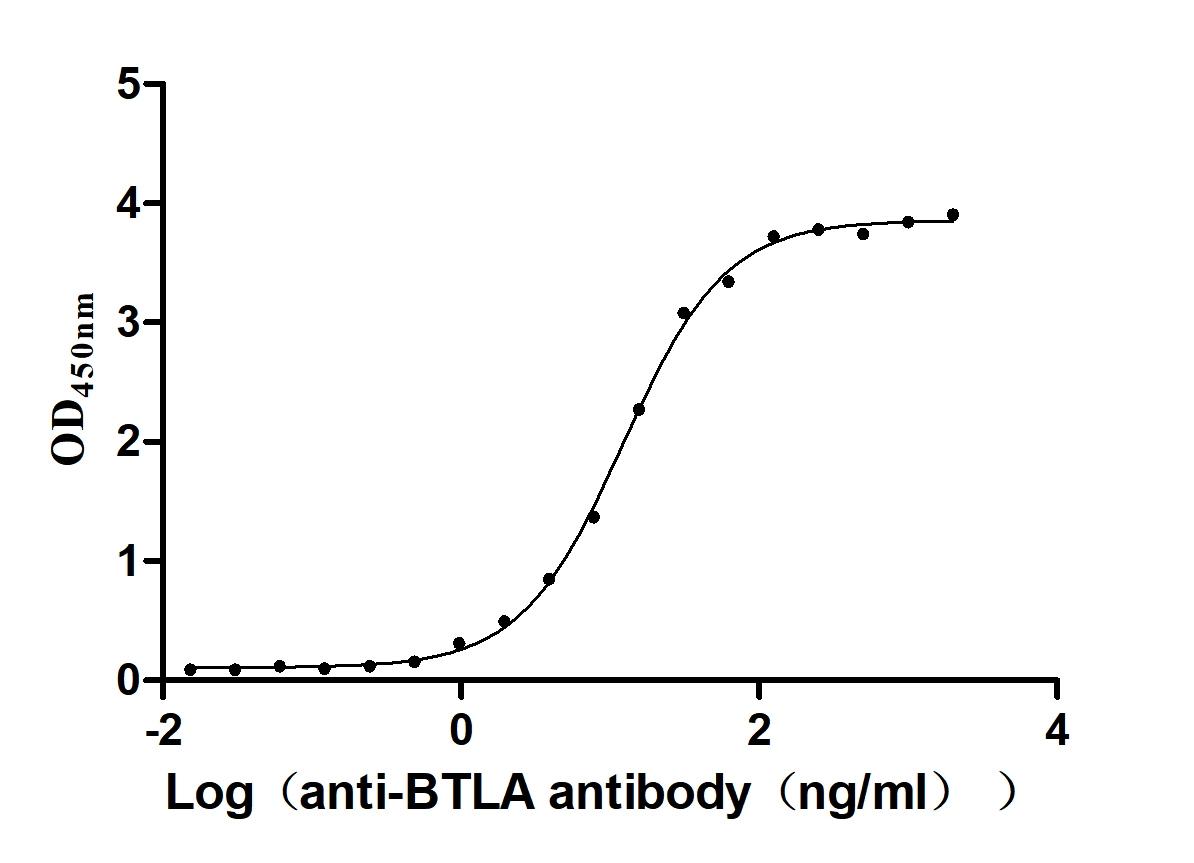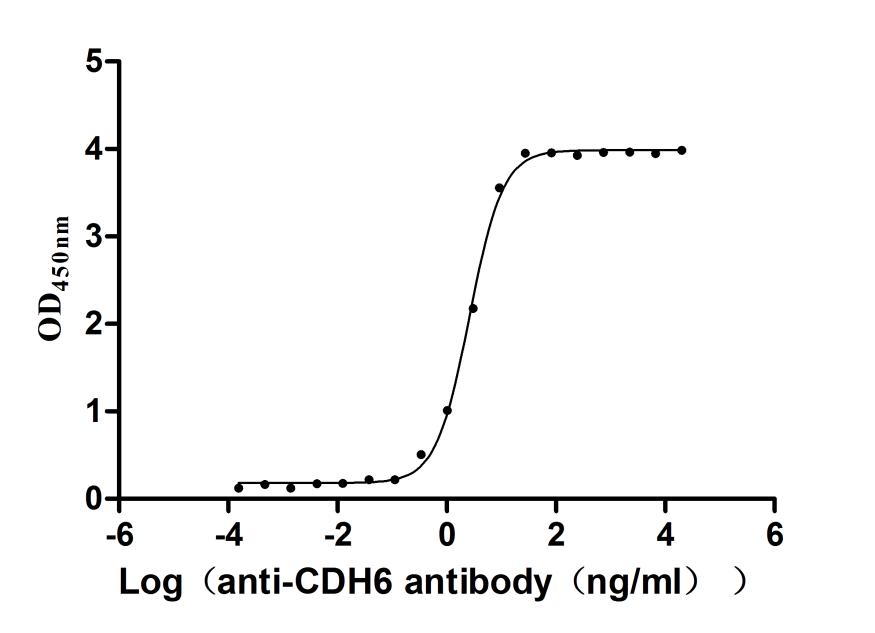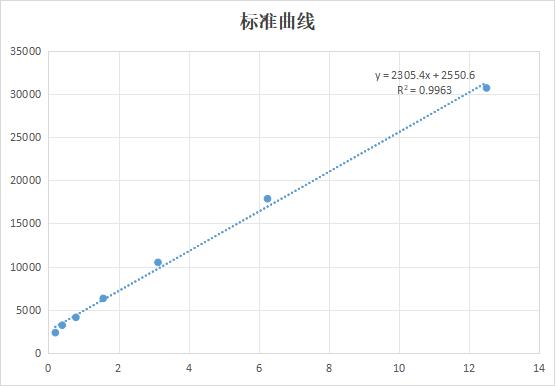Recombinant Human Apolipoprotein A-II (APOA2)
In Stock-
貨號:CSB-EP001915HU
-
規(guī)格:¥1536
-
圖片:
-
其他:
產(chǎn)品詳情
-
純度:Greater than 85% as determined by SDS-PAGE.
-
基因名:
-
Uniprot No.:
-
種屬:Homo sapiens (Human)
-
蛋白長度:Full Length of Mature Protein
-
來源:E.coli
-
分子量:21.7 kDa
-
表達(dá)區(qū)域:24-100aa
-
氨基酸序列QAKEPCVESLVSQYFQTVTDYGKDLMEKVKSPELQAEAKSYFEKSKEQLTPLIKKAGTELVNFLSYFVELGTQPATQ
Note: The complete sequence may include tag sequence, target protein sequence, linker sequence and extra sequence that is translated with the protein sequence for the purpose(s) of secretion, stability, solubility, etc.
If the exact amino acid sequence of this recombinant protein is critical to your application, please explicitly request the full and complete sequence of this protein before ordering. -
蛋白標(biāo)簽:N-terminal 6xHis-SUMO-tagged
-
產(chǎn)品提供形式:Liquid or Lyophilized powder
Note: We will preferentially ship the format that we have in stock, however, if you have any special requirement for the format, please remark your requirement when placing the order, we will prepare according to your demand. -
緩沖液:If the delivery form is liquid, the default storage buffer is Tris/PBS-based buffer, 5%-50% glycerol. If the delivery form is lyophilized powder, the buffer before lyophilization is Tris/PBS-based buffer, 6% Trehalose.
-
復(fù)溶:We recommend that this vial be briefly centrifuged prior to opening to bring the contents to the bottom. Please reconstitute protein in deionized sterile water to a concentration of 0.1-1.0 mg/mL.We recommend to add 5-50% of glycerol (final concentration) and aliquot for long-term storage at -20℃/-80℃. Our default final concentration of glycerol is 50%. Customers could use it as reference.
-
儲存條件:Store at -20°C/-80°C upon receipt, aliquoting is necessary for mutiple use. Avoid repeated freeze-thaw cycles.
-
保質(zhì)期:The shelf life is related to many factors, storage state, buffer ingredients, storage temperature and the stability of the protein itself.
Generally, the shelf life of liquid form is 6 months at -20°C/-80°C. The shelf life of lyophilized form is 12 months at -20°C/-80°C. -
貨期:3-7 business days
-
注意事項:Repeated freezing and thawing is not recommended. Store working aliquots at 4°C for up to one week.
-
Datasheet & COA:Please contact us to get it.
相關(guān)產(chǎn)品
靶點詳情
-
功能:May stabilize HDL (high density lipoprotein) structure by its association with lipids, and affect the HDL metabolism.
-
基因功能參考文獻(xiàn):
- Weight loss resulted from a reduction of HDL in both APOE-II genotypes. However, in C homozygote carriers, it was shown that HDL3 reduced significantly and leads to a general shift toward larger size HDL subfractions after intervention, while in T allele carriers HDL2 decreased significantly and weight loss leads to shift toward smaller size HDL subfractions. PMID: 28545455
- There was a statistically significant interaction between APOA2 polymorphism and dietary fatty acids intake on oxidative stress n patients with type 2 diabetes PMID: 27271094
- This study detected a reduced level of heterodimer apoA2-ATQ/AT and a specific apoA2 isoform hypo-processing pattern in the sera of autoimmune pancreatitis patients. PMID: 29481802
- In type 2 diabetes mellitus patients, the dietary intake of antiinflammatory fatty acids, such as omega-3 PUFAs and MUFAs, could reduce the inflammatory effects associated with the Apolipoprotein A2 CC genotype. In addition, proinflammatory fatty acids, such as SFAs, could overcome the antiinflammatory effect of the T-allele. PMID: 28359369
- data support an SR-B1 nibbling mechanism that is similar to that of streptococcal serum opacity factor, which also selectively removes CE and releases apoAI, leaving an apoAII-rich remnant. PMID: 28373285
- A new missense mutation in an Iranian population has a significant association with high-density lipoprotein cholesterol levels. PMID: 26590203
- ApoAII-ATQ/AT not only distinguished the early stages of pancreatic cancer from healthy controls but also identified patients at high risk for pancreatic malignancy. PMID: 26549697
- Plasma apoB pool size of VLDL containing apoA-II is much smaller than that of VLDL without apoA-II, and this was caused by a very low rate of secretion of this VLDL type into plasma. PMID: 26071654
- APOA-II polymorphism and oxidative stress is associated with poor prognosis in patients with type 2 diabetes. PMID: 26104730
- Apolipoprotein AII was detected as a protein associated with the urinary protein/urinary creatinine levels in pediatric idiopathic steroid-sensitive nephrotic syndrome PMID: 24633472
- Apolipoprotein A-II/B significantly improves risk prediction of overall survival, also in carotid surgery patients with lower LDL levels PMID: 25953375
- Apolipoprotein A-II and the regulation of high density lipoproteins in cardiovascular disease. [Review] PMID: 24012775
- We have cloned the cDNA encoding human ApoA-II and achieved its high-level secreting expression with a yield of 65 mg/L of yeast culture PMID: 24116940
- identified a statistically significant interaction between the APOA2 -265T > C variant and higher-fat dairy food intake in the Boston Puerto Ricans and replicated this relation in the GOLDN study PMID: 24108135
- Clinical studies demonstrate that apoA-II is a strong predictor of risk for CVD. There is no evidence, however, that selective therapeutic modification of apoA-II impacts on atherosclerosis and clinical outcomes.[review] PMID: 21501035
- These data suggest Apo-AII-containing high-density lipoproteins (HDL) formed intrahepatically are likely cholesterol-rich compared to the smaller intracellular lipid-poor Apo A-I HDL. PMID: 23025327
- Enrichment of apo A-II in high-density lipoprotein particles has atheroprotective effects and apo A-II may become a target for the treatment of atherosclerosis. PMID: 23241412
- We conclude that apoA-II plays a significant role in apoE-associated risk of incident CVD in women with high levels of HDL-C and CRP. PMID: 22723940
- APOA2 m265 genotype may be associated with eating behaviours and dietary modulation of plasma ghrelin. PMID: 21386805
- a gene-diet interaction involving the APOA2 -265T>C SNP and saturated fat intake determines body weight in a Mediterranean and an Asian populations PMID: 20975728
- Human apolipoprotein A-II inhibits the production of interferon-gamma by concanavalin A-stimulated mouse and human CD4-positive T cells. PMID: 21300819
- Low apolipoprotein-A2 is associated with metastatic renal cell cancer. PMID: 20022911
- ApoA-II plays a crucial role in triglyceride catabolism by regulating lipoprotein lipase activity, at least in part, through HDL proteome modulation. PMID: 19910634
- The serum apoA-II concentrations confer risk for MetS and diabetes and exhibit evidence of anti-inflammatory properties among Turks. PMID: 19817643
- In metabolic syndrome, fenofibrate, but not atorvastatin, influences high density lipoprotein metabolism by increasing the transport of APOA2 particles. PMID: 19651918
- when expressed in transgenic mice, HDL shows antioxidant properties PMID: 11971944
- Overexpression in transgenic mice does not increase their susceptibility to insulin resistance and obesity PMID: 12032642
- Evaluated as a positional candidate gene for familial Type II diabetes, altered lipid concentrations, and insulin resistance PMID: 12136402
- Crystallographic studies of apo A-II and its complex with lipid surrogate beta-octyl glucoside show that disulfide-linked dimers of apo A-II form amphipathic alpha-helices which aggregate into tetramers. PMID: 12269810
- Carriers of a novel splice-site mutation in the LDL-receptor gene were simultaneously homozygous for the -265C variant of apoA-II thus concluding that one variant of the apoA-II gene was associated with reduced plasma LDL cholesterol in FH patients PMID: 12522687
- This protein inhibits high density lipoprotein remodeling and lipid-poor apolipoprotein A-I formation PMID: 12690114
- Genetic association of plasma apolipoprotein A-II levels with familial combined hyperlipidemia. PMID: 12738753
- Analysis of trancription factors that bind response elements in the apoA-II promotor and modulate transcription. PMID: 12959642
- apoA-II affects both the structure and the dynamic behavior of HDL particles and selectively modifies lipid metabolism PMID: 14967812
- In transgenic mice overexpressing the human apoA-II gene, plasma human apoA-II concentration was positively correlated with blood glucose levels. PMID: 14988251
- this protein-exonic splicing enhancer interaction is able to promote the incorporation of exon 3 in mRNA and suggest that they can rescue the splicing despite the noncanonical 3' splice site. PMID: 15247216
- Overexpressed human apoA-II in mice impairs HDL protection of apoB-lipoproteins from oxidation. Displacement of PON1 by apoA-II may explain why PON1 is found in HDL particles with apoA-I, not apoA-II, & apo-A-II-rich HDL's poor antiatherogenic properties. PMID: 15388641
- results indicate a significant association between the T265C APOA-II polymorphism and levels of visceral adipose tissue in premenopausal women present in white but not African-American women PMID: 15833935
- Characterization of regulatory elements found in the apoA-II exon 3 and its flanking introns that are involved in the control of apoA-II exon 3 splicing. PMID: 16254078
- the association of apoA-II with triglyceride-rich lipoproteins occurs in the circulation and induces postprandial hypertriglyceridemia PMID: 16990646
- ApoA-II adopts a beltlike structure in which the protein helices wrap around the lipid- bilayer reconstituted high density lipoprotein (rHDL) disc. PMID: 17264082
- ApoAII is efficiently reabsorbed in kidney proximal tubules in relation to its plasma concentration PMID: 17652309
- carriers of the minor allele for Apo A-II -265T/C (CC/TC) have a lower postprandial response compared with TT homozygotes PMID: 17709437
- ApoA-II is associated with a decreased risk of future coronary artery disease in apparently healthy people, implying that apoA-II itself exerts effects on specific antiatherogenic pathways. PMID: 17923573
- APOAII rs5082 polymorphism may have a role in reducing risk of coronary artery disease in an Australian male population PMID: 18179799
- results for dimeric apolipoprotein AII are similar to those we have reported for the monomeric apolipoprotein CI, which has a similar secondary structure but a different peptide sequence and net charge PMID: 18652418
- procoagulant activities of plasma factor VIIc and factor Xc are positively and independently associated with concentrations of the high-density lipoprotein apolipoprotein, apo A-II PMID: 18766253
- small sizes (i. e., number of kringle-4 repeats in the gene) of apolipoprotein (a) are risk factors for the development of atherothrombosis. (review) PMID: 19069164
- Results indicate that CETP inhibition increases plasma concentrations of apoA-II by delaying HDL apoA-II catabolism and significantly alters the remodeling of apoA-II-containing HDL subpopulations. PMID: 19193611
- The available data does not support a role for common variants in APOA2 on type 2 diabetes susceptibility or related quantitative traits in Northern Europeans PMID: 19216768
顯示更多
收起更多
-
亞細(xì)胞定位:Secreted.
-
蛋白家族:Apolipoprotein A2 family
-
組織特異性:Plasma; synthesized in the liver and intestine.
-
數(shù)據(jù)庫鏈接:
Most popular with customers
-
Recombinant Human Tumor-associated calcium signal transducer 2 (TACSTD2), partial (Active)
Express system: Mammalian cell
Species: Homo sapiens (Human)
-
Recombinant Human Myosin regulatory light polypeptide 9 (MYL9) (Active)
Express system: Yeast
Species: Homo sapiens (Human)
-
Recombinant Human B- and T-lymphocyte attenuator(BTLA), partial (Active)
Express system: Mammalian cell
Species: Homo sapiens (Human)
-
Recombinant Human Cadherin-6(CDH6),partial (Active)
Express system: Mammalian cell
Species: Homo sapiens (Human)
-
Recombinant Human Urokinase-type plasminogen activator(PLAU) (Active)
Express system: Mammalian cell
Species: Homo sapiens (Human)

